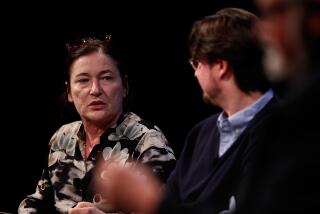Making Book on a Pair of Queens : THE VIRGIN QUEEN: Elizabeth I, Genius of the Golden Age, <i> By Christopher Hibbert (Addison-Wesley: $25; 336 pp.)</i> : TO THE SCAFFOLD: The Life of Marie Antoinette, <i> By Carolly Erickson (William Morrow: $22.95; 448 pp.)</i>
- Share via
They had absolutely nothing in common. One was regnant, the other consort. One was a spinster, the other a wife and mother. One was a bluestocking who translated Latin and Greek for fun, the other was a Hapsburg Tammy Faye Bakker who shopped till she dropped. Yet different as they were, their lives prove the same point: Femininity is woman’s worst enemy.
Elizabeth I had the good luck to be born into a masculine age. The Renaissance was a period of classical revival that took its leaf from the stern Roman model lauded by Machiavelli in his concept of virtu--not “virtue” in the modern sense of placid goodness, but a mode of behavior derived from the root meaning of vir , the Latin word for male. Virtu referred to the Renaissance ideals of courage, glory and creative achievement. How Elizabeth Tudor met these standards and became the greatest man of her time is recounted by Christopher Hibbert in prose of such lyric beauty that history in his hands becomes one of the fine arts.
Elizabeth seems to have been one of those rare individuals born with an ear for human psychology comparable to an ear for music. Like William Shakespeare, whose name would ever be linked with hers, she seemed to “know” the innermost workings of the human mind and never shrank from the unpalatable truths that most people refuse to admit.
She “knew,” for example, that men, for all their protestations to the contrary, secretly despise feminine traits. Consequently, she flaunted rather than hid her intellect, winning plaudits from her tutor, the great Renaissance scholar Roger Ascham, who said that her mind was so well stocked that he was learning from her instead of the other way around.
At 5, she hunted with the men; making sure she was in on the kill, she slit the throat of a stag without a trace of girlish squeamishness. Around this time, her first suitor, Lord Edward Courtenay, withdrew his offer, saying he would prefer to marry “some simple girl,” but her preference for respect over love paid off when she was imprisoned in the Tower and her jailer “found her too intimidating to treat otherwise than with cautious correctitude.”
She also “knew” that the masses are innately conservative. Having seen the common people rally round her father’s discarded first wife, Catherine of Aragon, with cries of “God save Queen Catherine” while they castigated her own mother, Anne Boleyn, with epithets like “goggle-eyed whore,” she sensed that it had less to do with Catholic-Protestant politics than with the visceral threat of female sexuality. To be a powerful queen she must personify the feminine ideal of chastity, yet to be a powerful ruler she must at the same time be masculine.
She navigated this Scylla and Charybdis by turning virgin into a buzzword, using the happy coincidence of her astrological sign, Virgo, in the same way she used the New World by naming it Virginia. Despite her official Protestantism, she stage-managed her processions to appropriate the Virgin Mary cult, letting herself be carried aloft so often that the ostensibly hostile Catholic subjects called her the “second Maid.”
At the same time, says Hibbert, she managed subtly to imply that she was not really a woman at all. “The Queen herself was ready to admit that women were the weaker sex. . . . She would refer to herself as a ‘mere woman.’ At the same time she insisted that, although a woman, she was a very special woman.” Always the Latin scholar, she must have had in mind the vir root of virgin when she painted herself as a man-woman in her speech before the Armada: “I know I have the body of a weak and feeble woman, but I have the heart and stomach of a king, and of a king of England too.”
Her ear for human psychology proved true. Said the French ambassador: “All ranks of her subjects fear and revere her, and she rules them with full authority, which I believe she scarcely could do were she a person of ill fame, lacking virtue.” Whether or not she was a virgin in the technical sense, she was surely a virago in the original sense of that now-debased word: a woman of stature, strength and courage who is not conventionally feminine.
In our present sexually confused age, when every flailing move women make is carefully called a “choice,” Elizabeth’s undeviating credo is still the best definition of feminism: “Beggar woman and single, far rather than queen and married.”
The immediacy and easy intimacy that Carolly Erickson brings to her study of passive-reactive Marie Antoinette makes the doomed Queen of France as hauntingly familiar as the case studies in Colette Dowling’s “The Cinderella Complex: Women’s Hidden Fear of Independence” and Nancy Friday’s “My Mother, Myself.”
Maria Theresa, Empress of Austria, was an impossible act to follow. On the day that Antoinette, her 15th child, was born, the efficient empress decided that as long as she was in labor, she might as well have a sore tooth pulled to schedule all her pain on one day. After undergoing an extraction without anesthesia, she worked on state papers while timing her labor pains. After her daughter was born, the consummate career woman went back to her state papers.
Overwhelmed by this superhuman example of iron self-discipline and devotion to duty, the naturally sunny and easygoing Antoinette simply gave up and took refuge in averageness. The erosion of her self-esteem continued by mail when, as Dauphine and later Queen of France, she was bombarded by maternal letters full of nagging advice on how to run a country and cold assessments such as, “I see you striding with nonchalant calm toward ruin.”
Always eager to please, Antoinette obediently tried to help Louis govern, but, raised to be good rather than learned and never exposed to anything more taxing than what her mother called “reasonable reading” (bucolic novels), she soon realized that she had neither the intellect nor the strength of character to cope with affairs of state. “Where wisdom and effective leadership were called for, she offered only anxiety and diligence.”
Maria Theresa’s good cop-bad cop letters kept her daughter constantly off balance. After praising Antoinette’s gift for making people like her, she added: “You owe it neither to your beauty (which in fact is not so great), nor to your talents or culture (you know very well you have neither); it is your kind heart. . . .” Thrown back on her kind heart and the beauty her mother had denigrated, Antoinette filled her days with parties and fashion, becoming a prisoner of femininity in the most literal sense in the exhausting daily ritual of the “Grande Toilette.”
In a horrendously detailed chapter on Antoinette’s obsession with her looks, Erickson describes what she went through to achieve her towering hairdos. “Hours in the construction, these creations were naturally preserved as long as possible, which meant that the scalp, itching and perspiring under its heavy load, had to be protected with pomade. But the pomade, being organic, turned rancid within a few days, and to its stink was added the torment of sharp pins . . . . Hair fell out, teeth ached, fleas and lice bred in the nests of curls; genteel women carried long thin sticks with small ivory claws at the end to reach into their headdresses and scratch their heads.” Lack of sound sleep added to Antoinette’s nervous strain, for at night “the whole erection is compressed by means of a sort of triple bandage which everything goes under, false hair, pins, dye, grease, until at last the head, thrice its right size, and throbbing, lies on the pillow done up like a parcel.”
Erickson presents as fact the famous and disputed story that Marie Antoinette apologized to the executioner when she accidentally trod on his foot as she mounted the guillotine. Reactionary historians like to attribute this insane punctiliousness to noblesse oblige, but in light of myriad self-help books about women who are held back by their fear of not being “nice,” it sounds more like femininity’s last stand, and as such rings depressingly true.
Fortunately, we can chase it with Elizabeth Tudor’s reply when asked why she forbade English diplomats to accept foreign medals: “My dogs wear my collars.”
More to Read
The biggest entertainment stories
Get our big stories about Hollywood, film, television, music, arts, culture and more right in your inbox as soon as they publish.
You may occasionally receive promotional content from the Los Angeles Times.










